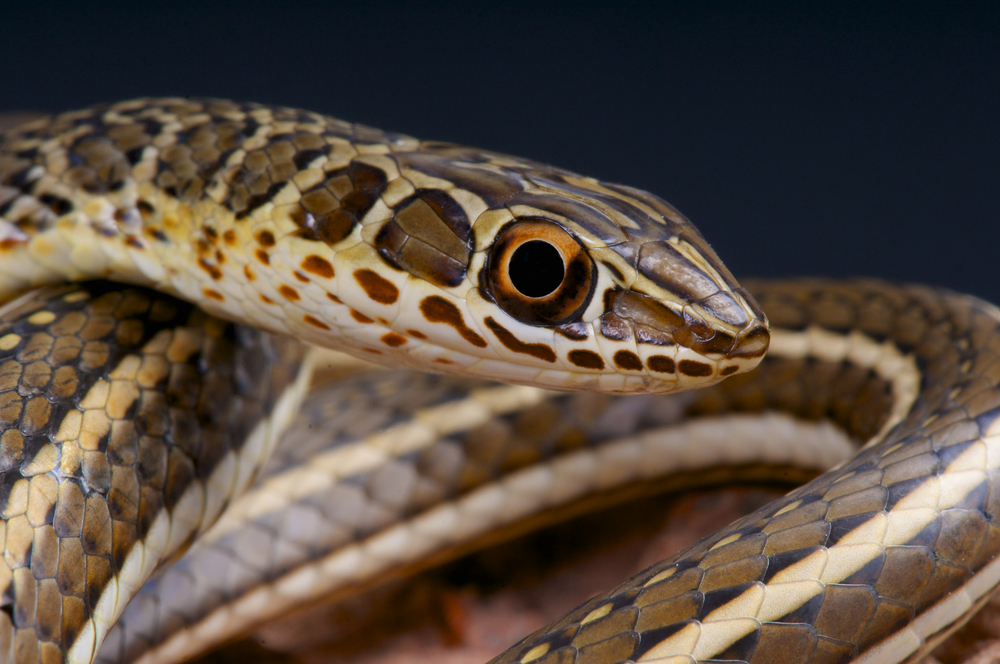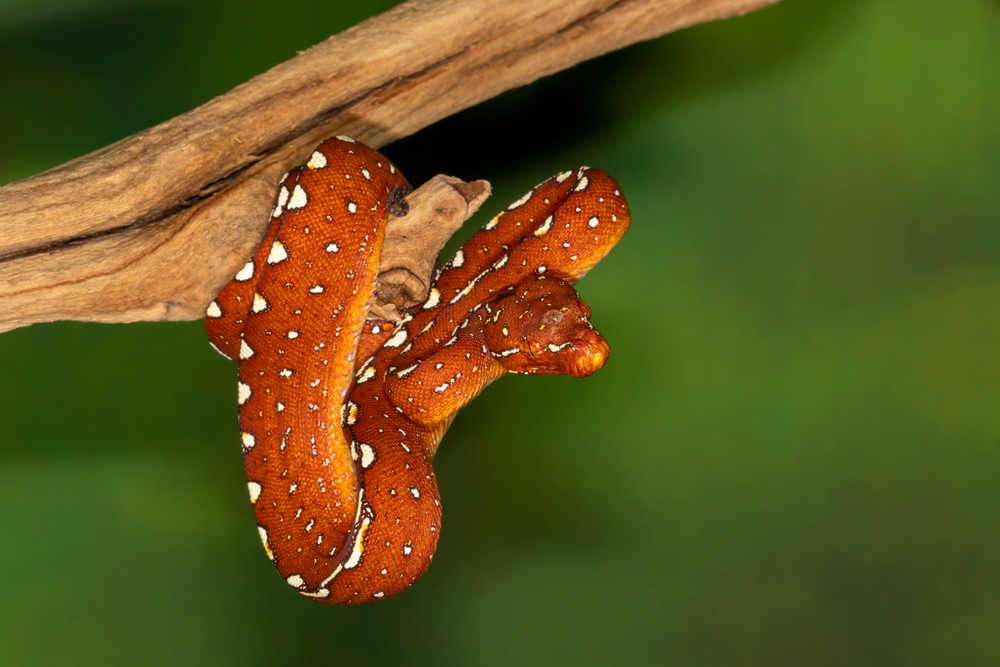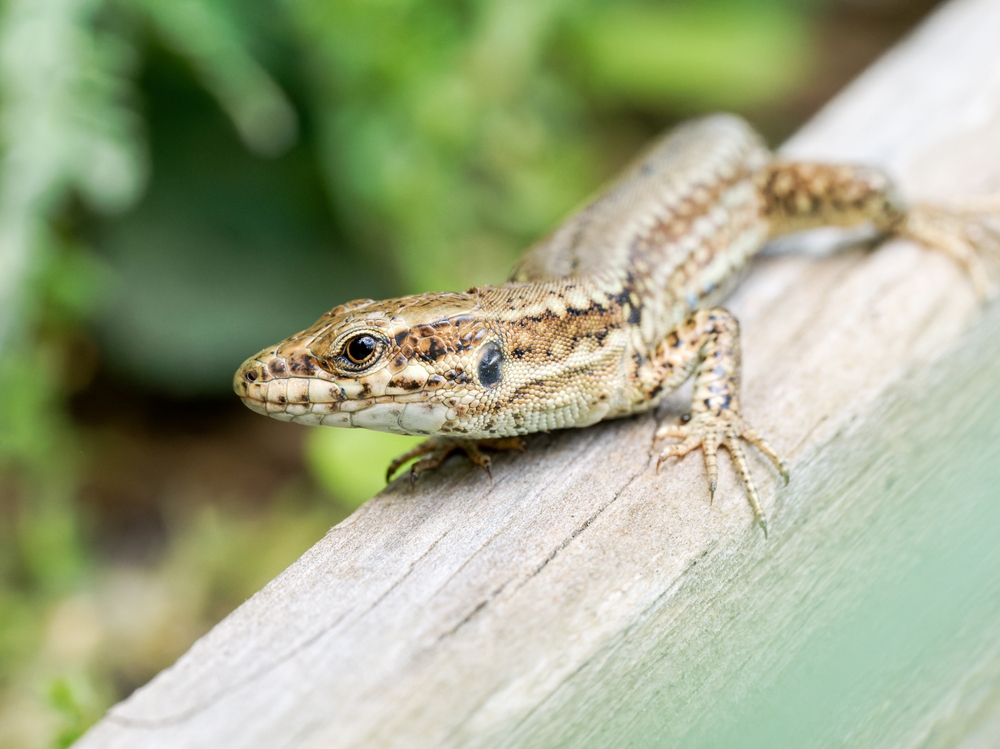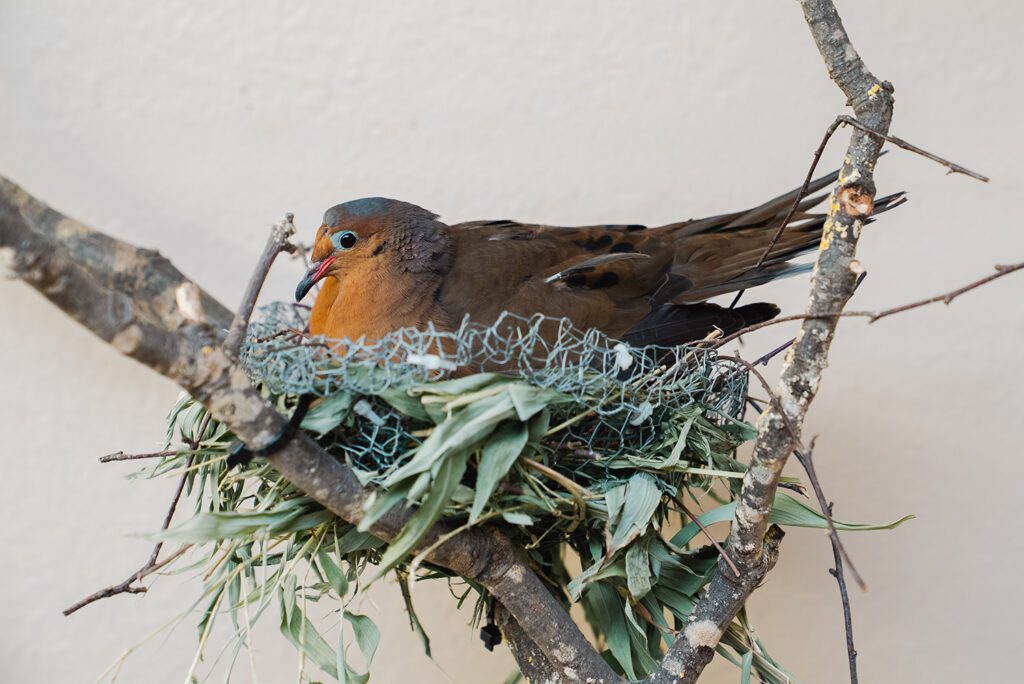The hissing sand snake is a slender-bodied, venomous snake from North Africa. Poorly represented in the hobby, these unique reptiles were occasionally imported from Egypt in the early 00s, with only a handful of enthusiasts keeping and breeding the species. One such enthusiast is Francis Cosquieri, a specialist snake keeper from Gibraltar. The following feature discusses his extensive research into the husbandry of these little-known animals.
Hissing Sand Snake Appearance & Sexing
The Hissing sand snake is a medium-sized Psammophiine snake that can reach a total length of 144cm. It is slim and elegant snake with an elongated head and large eyes sporting round pupils. The tail is relatively long and attenuate and accounts for about a third of the length of the snake.
In coloration this is a variable species. Generally, the body is brownish with a cream or yellow vent that sometimes has two thin brown or reddish lines along the edges. They also typical have longitudinal striping. Both sexes are almost identical in appearance so the best way of sexing them is to look at the snake’s shed skin. In males, the hemipenis will also shed and these can easily be seen on the snake’s shed skin. While it is not always a conclusive method, waiting for three sheds to check should reveal the sex of your Hissing sand snake.


Hissing Sand Snake Distribution, Habitat and Ecology
The true distribution of the Hissing sand snake remains an issue, as the currently recognised range probably includes that of several species formerly assigned to this taxon. Historically, the range includes northern Africa from Algeria to Egypt (but not Morocco) and as far south as Angola, Zaire and the Democratic Republic of the Congo, and as far east as Somalia and Eritrea.
Despite its common and binomial names of “hissing sand snake,” P. sibilans is not really a desert species although it can occur in arid habitats. Usually, it is found in grassy plains, fields, floodplains, water margins and cultivated lands. They are tolerant of anthropogenic change and can colonise farmland and other areas disturbed by humans. In Egypt (from which most imported specimens come from) they are restricted to the Nile Valley and Nile Delta between Cairo and Aswan.
A high percentage of individuals in populations can show damaged or even completely lost tails. This is not true autotomy (as in some lizards) but is due to this species’ propensity to spin wildly when grasped by the tail, thus causing a break between the vertebrae at the point where it is held. The tails do not grow back but the tail tip may continue to wriggle independently for some minutes and the broken tail tip may be remodeled into a blunt cone.
Hissing sand snakes are dietary generalists, taking lizards, smaller snakes, rodents and small birds. They are active “search and pursue” hunters that display the peculiar habit of “periscoping” to assess their environment, wherein they raise the head and anterior part of the body from the ground to look around. This can give them a somewhat “cobra-like” appearance, although they don’t use the behaviour as a defence (preferring to flee at any opportunity when threatened) but rather to spot potential prey or predators.
The large eyes give away that these are sight-oriented animals, and they take in any movement in their proximity. Psammophis take a great interest in comings and goings outside their enclosure and will spend as much time watching the keeper as the keeper will watch them!
Psammophis are venomous and rely on their venom to dispatch prey, which they often hold down with several coils whilst the venom subdues it. Although few snakes of this family are medically significant, very rapid death of lizards has been observed, suggesting venom specificity toward this type of prey. It should also be noted that the venom glands are very large and well developed and extend well beneath the eye. Despite this, hissing sand snake were removed from the Dangerous Wild Animals Bill in 2007.
One of the more intriguing aspects to Psammophiid behaviour is the sociality of some species. Many snakes of this family including Psammophis possess narial valves that secrete a solution of lipids, proteins, fatty acids, K+ and NA+ ions that the snake uses to smear its flanks and vent with odd, jerky head movements. If keeping hissing sand snakes, sooner or later you will come across this behaviour. Psammophis will also perform these “scenting” behaviours on landmarks within their habitat. There are several suggested reasons for this behaviour; one is that the secretion may help prevent water loss to these snakes, which inhabit dry areas. Another is that they are some forms of attractant to the opposite sex. Yet another is that they are used to delineate territory and hunting routes by rubbing off on the world around it as the snake moves around. I have also witnessed specimens of both P. sibilans and P. schokari performing these rubbing behaviours on one another. This is one of the more interesting aspects of the behaviour of hissing sand snakes.
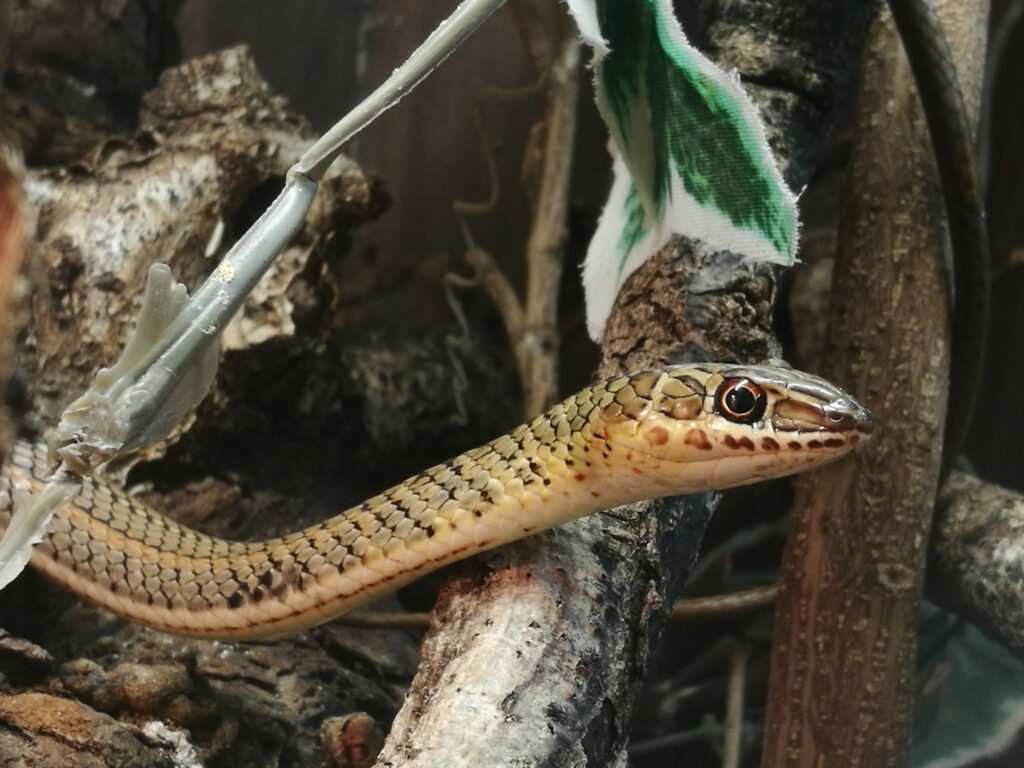
Hissing Sand Snake Enclosures
In captivity, hissing sand snakes are relatively easy to keep, requiring only dry, warm conditions. A small water bowl is necessary, although they will rarely if ever be seen to drink from it. They require warm temperatures with a large drop at night to room temperature.
As with all snakes, there are two schools of thought when housing this species. As probably the hardiest species of the genus, they can survive perfectly well in a sterile system, however, to really experience how active and interesting hissing sand snakes can be, a more naturalistic, large enclosure is recommended.
Hissing sand snakes are fast-moving, active and inquisitive. They would really appreciate a larger terrarium in which to rove and explore. In this way they will provide the keeper with hours of entertainment, and perhaps some of the interesting behaviours for which they are becoming known. I recommend no less than 48”x18”x18” for a single specimen and preferably more to really appreciate the snake’s movements and activity. This snake will climb readily into branches and over rocks, but it is also good to provide large open areas for them to traverse, as they are primarily a terrestrial species.
Psammophis like to climb up as high as they can, from where they will watch comings and goings around them outside the enclosure. A fake rear wall will give them an added dimension to explore. Good terrarium ornaments are pieces of banana root or bamboo root, various rocks and dried grapevine. If you can add a little more height to the enclosure this will be appreciated, as this species really likes to take up a position at the top of its territory from where it can survey the world. From here, you will often notice the snake watching you with as much interest as you are watching it. No movement outside the terrarium goes unnoticed by their keen eyes.

Hissing Sand Snake Heating and Lighting
Being a diurnal, sun-worshipping species, hissing sand snakes relish bright light. A UV Index above the basking zone of around 3 is recommended, providing the snake has the opportunity to get out of the UV should it choose to. This can easily be accomplished by only positioning UV lights over a third to a half the length of the enclosure. The snake can be allowed to regulate its exposure to UV by positioning perches at different heights and distances away from the lamps. Psammophis will often try to approach as close to the UV light as they can. With the older T8 fluorescent bulbs, as here, this is not so much of a problem, but the newer T5 bulbs emit high UV at close range, so should be guarded.
The fluorescent lights are left on for 14 hours a day and a halogen spotlight for 10 hours, under which hissing sand snakes will thermoregulate. This is a species that really appreciates a decent hot zone; around 40℃ surface temperature at the basking zone is adequate, with a thermal gradient down to about 22℃ at the cool end of the enclosure. A larger enclosure could have a basking zone surface temperature even higher, providing that the thermal gradient is not compromised. Hissing sand snakes snakes will certainly inhabit very hot areas at least temporarily but not allowing them to cool off when they need to is dangerous. My favourite way of providing heat for these sun-basking snakes is to use a halogen bulb. These emit far more near infra-red radiation (which more closely approximates sunlight) and warm the surface beneath them better. If you place a flat rock or piece of slate or tile beneath it, this will make an ideal basking surface for the snakes. Good ventilation is also needed, so that a hot spot can be provided without fear of overheating the rest of the enclosure, and a thermal gradient is easier to create. Hissing sand snakes will be seen to spend much of their time basking, and then moving into the cooler areas to explore, before returning to bask some more.
For the substrate, I use a mix of play sand, potting soil (this should have no additives such as pesticides, fungicides or fertilisers) and coco coir. This should be mixed to a consistency where if you poke your finger into it, the hole remains. This will allow the animal to burrow. A layer of dry leaves or dry grass can be added on top of this to taste; this will give the snake some cover, something to explore, and a means to bask cryptically should it wish to. Hissing sand snakes are not a species that tends to burrow often, so does not need a particularly deep layer of substrate. About 3-4” is enough, topped with dead leaves and/ or grasses.
A period of mild cooling (about 5-6 weeks) should be provided around October/ November, when the spotlights are not turned on. The fluorescent lights are left on for 8 hours a day during this period. It is possible to keep this species in small groups, but as their prey in the wild includes smaller snakes, it is advised that only specimens of similar size are housed together; in addition, having more than one of these very fast-moving snakes to contend with when servicing the enclosure can become difficult if they are all trying to escape, so caution is advised. However, in this manner some interesting social interactions between individuals can be witnessed.

Hissing Sand Snake Husbandry and Feeding
In the wild hissing sand snakes are dietary generalists, taking lizards, smaller snakes, rodents, frogs and small birds. Baby specimens probably take a certain proportion of insect prey also and have been observed to take orthopterous insects (crickets, locusts, grasshoppers, etc) in captivity. In the terrarium, adults prove not fussy and readily accept frozen and thawed rodents of the appropriate size. Getting adults to feed is rarely a problem; many will accept prey from forceps within days of being acquired, despite otherwise being shy of the keeper. Others may only take food left overnight at first, but these snakes will usually calm down enough that they will approach the keeper to accept food from forceps and some can be downright aggressive when it comes to attacking offered food.
As hissing sand snakes are venomous, long tongs or forceps are necessary. This species is an eager feeder and will ‘beat’ prey side to side once grabbed to help immobilise it. This can lead to quite a mess if frozen/ thawed prey ruptures. This is an active species that has a high metabolism and requires feeding more regularly than most snakes. The author prefers several small feeds at regular intervals, usually every 5-7 days; the snakes seem to manage smaller prey better than large prey items. The snakes will feed gluttonously on this regimen and very rarely if ever will miss a feed if healthy.
Variety can be provided by offering differing sizes and types of food on different feeding days; small adult mice, pinks, fluffs, hoppers, rat pups, young multimammate mice and quail chicks are all accepted readily. The largest specimens are also able to handle smaller gerbils and small hamsters, which can also be purchased frozen. Baby specimens, particularly neonates, are a different kettle of fish and can be difficult to raise. In the absence of small lizards or frogs, most will swallow pieces of pink mouse or mouse-tails that are assist-fed, but this is a painstaking and slow process. Once the babies are large enough to accept pink mice they will grow far more rapidly. It is suggested that should small lizards (for example Mourning Geckos) be available these would be the most ideal food source for the babies.

Hissing Sand Snake Breeding
After a period of around eight weeks of cooling, upon the advent of longer lighting periods, the first mating of hissing sand snakes was observed in 2008, which resulted in 10 very rounded eggs being deposited by one of the females. The eggs were incubated in a plastic tub half-filled with water that was heated by an aquarium heater. The eggs were suspended above the water on women’s tights at a temperature of 28℃. This resulted in hatchlings after 61 days. In subsequent years I have often had further breedings of this species. Once acclimated and eating well, they are not problematic to breed, although raising the juveniles can be a chore until they are the right size to eat pink mice. The neonates often will not accept pinkies at first but readily assist-feed on pinky parts and pieces of chopped mouse tail. Several of them were also observed to stalk and devour crickets placed into tubs. Fed in this way every 2-3 days, they eventually come around to voluntarily taking whole pinkies.
At this point, raising the baby hissing sand snakes became unproblematic for the most part. The babies were initially kept in spartan enclosures; paper towel was considered too absorbent and retained too much moisture for them, so plain printer paper was used. For one clutch, old socks were used for hides, in which the babies eagerly hid with their heads often peeking out of the mouth to take in their surroundings, which is always an odd and somehow delightful sight. They are so small at hatching that one must be careful to house them in enclosures that present no opportunities for them to escape. They will easily get out of the ventilation slots of an Exo Terra terrarium or between the lid of a Really Useful Box, for example. Faunariums are recommended until they are large enough to be safely housed in more suitable enclosures.
Summary
This is unfortunately a very overlooked genus, even though hissing sand snakes make hardy, undemanding and very interesting pets. They are inquisitive, active and entertaining snakes that are almost always in view, active during the day and really set off by a well-designed vivarium. They also provide interesting behaviours not seen in other snakes. Hopefully in the future there will be more successes inspired by the trickle of captive-bred specimens being born to a handful of devout European enthusiasts.
By Francis Cosquieri
Nature’s Imitation Game: Emerald Tree Boas and Green Tree Pythons
High in the forests of South America and the Indonesian archipelago, jewel-toned snakes drape themselves…
The Wall Lizards of Ventnor Botanic Garden
Tucked away on the sun-soaked southern coast of the Isle of Wight, UK lies a…
Thinking Like a Snake: Field Insights into Emerald Tree Boa Husbandry
Among keepers, few snakes inspire as much awe as the emerald tree boa (Corallus sp.)….
Herping Arizona Monsoons 2025 – Part One
Arizona encompasses vast stretches of Sonoran, Colorado, and Mojave Deserts. It’s scattered with 10,000-foot-high mountains…
“Extinct” Doves Hatch at Chester Zoo
Eight chicks belonging to a dove species that has been extinct in the wild for decades…
Naming Nature: Where Taxonomy Meets Pop Culture
From David Bowie’s lightning bolt immortalised in the iridescent fur of a spider, to Jackie…
